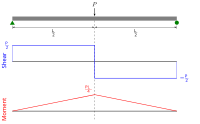Bending moment

Bending moment is like a giant hug that a beam gives to things that are resting on it. You know how when you hug someone really tight, your arms put pressure on their body? Well, a beam is like your arms and the things resting on it are like the person you're hugging.
When something heavy rests on the beam, like a bag of flour, it creates a force that pushes down on the beam at one point. But the beam can't just give up and break, so it distributes that force throughout its length. That's where bending moment comes in - it's the measure of how much the beam is "hugging" the weight that's resting on it.
Think of it like this: when you hold a heavy object in your hand, your arm muscles are working hard to keep it from falling. If you hold it for too long or it's too heavy, your muscles start to ache. The same thing happens to a beam - the more weight it has to hold up, the harder it has to "hug" and the more the beam itself bends. The bending moment is the amount of force required to make the beam bend a certain amount.
So, when you hear people talking about bending moment, they're really talking about how much weight a beam can hold before it starts to bend too much or break. It's important to know this information if you're designing or building something that needs to support a lot of weight, like a bridge or a skyscraper.
When something heavy rests on the beam, like a bag of flour, it creates a force that pushes down on the beam at one point. But the beam can't just give up and break, so it distributes that force throughout its length. That's where bending moment comes in - it's the measure of how much the beam is "hugging" the weight that's resting on it.
Think of it like this: when you hold a heavy object in your hand, your arm muscles are working hard to keep it from falling. If you hold it for too long or it's too heavy, your muscles start to ache. The same thing happens to a beam - the more weight it has to hold up, the harder it has to "hug" and the more the beam itself bends. The bending moment is the amount of force required to make the beam bend a certain amount.
So, when you hear people talking about bending moment, they're really talking about how much weight a beam can hold before it starts to bend too much or break. It's important to know this information if you're designing or building something that needs to support a lot of weight, like a bridge or a skyscraper.
Related topics others have asked about:
